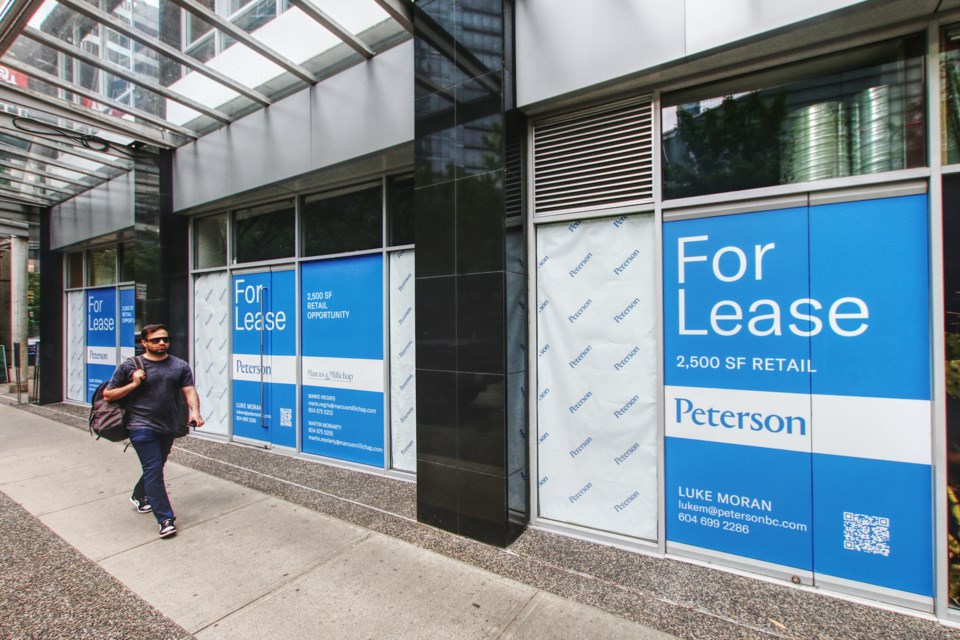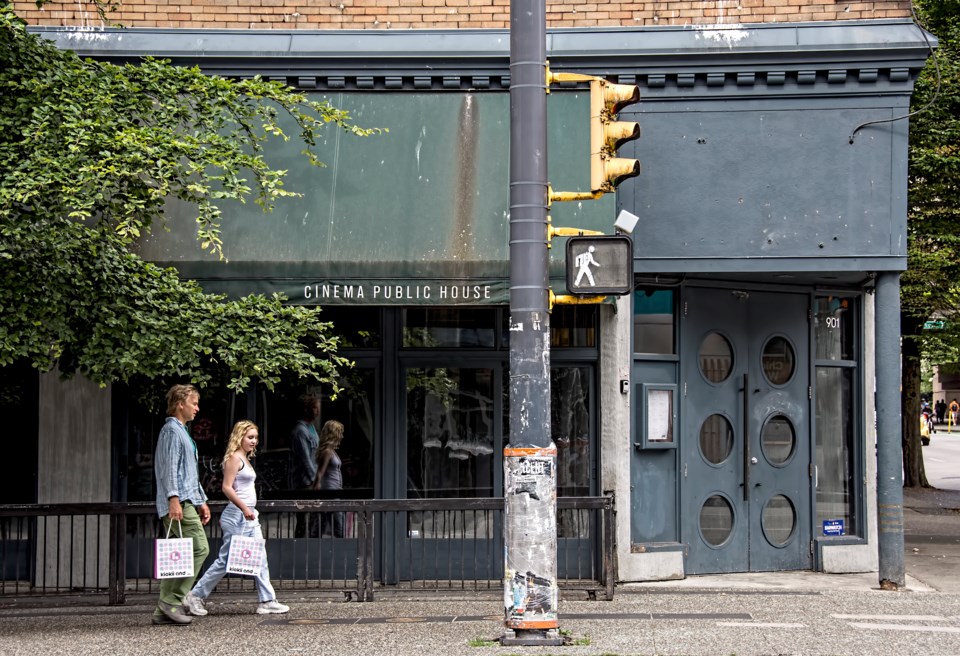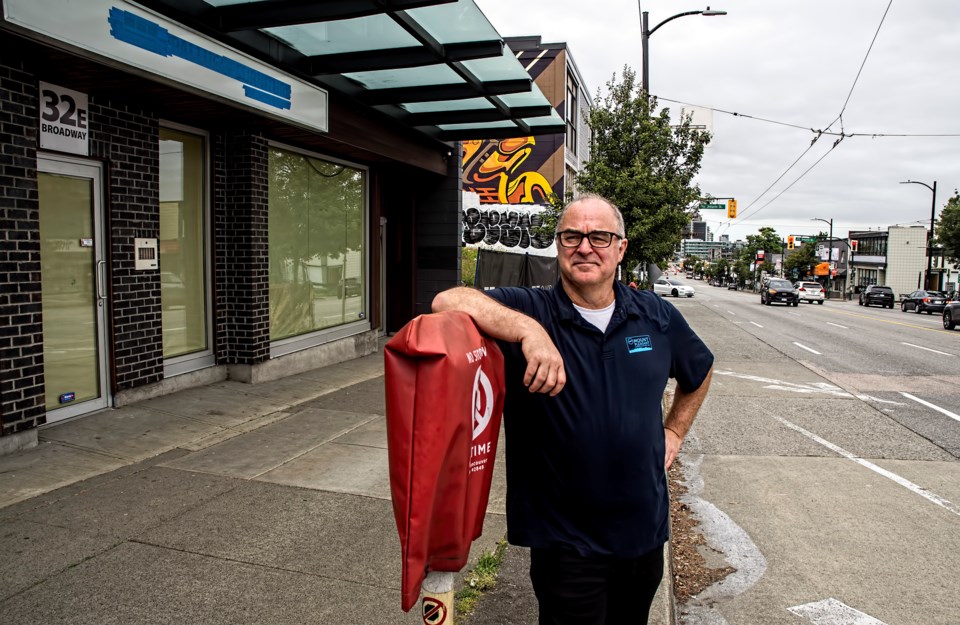Empty storefronts can be part of healthy retail districts — signs that new tenants may be navigating permits through city hall or renovating premises before they open a refreshed space.
Vancouver has, however, seen a rise in vacant storefront properties, particularly in key retail areas such as Alberni Street, downtown Granville Street and the Broadway Corridor.
Some sites have been vacant for years, depriving owners of getting what can be substantial rent.
Reasons vary.
Properties may have site-specific reasons for being empty, or be vacant because of larger neighbourhood trends.
Alberni Street readying for new tenants
Colliers International's most recent retail report found Alberni Street’s luxury strip had a 12.49 per cent vacancy rate — the highest rate in the city among retail corridors that Colliers tracks.
Colliers does not show rates for downtown Granville Street or the Broadway Corridor in its reports.
The Alberni Street strip may appear to be having a tough time but the reality is that most vacant sites are leased, with new tenants prepping them for reopening, according to realtors.
One site in the prime 1000 block of Alberni Street has a window with a red “leased” sticker on top of a for-lease sign.
Montecristo Jewellers has temporarily closed its store at 1037 Alberni Street and placed laminated branding on its windows to obscure views inside. An employee told BIV that the store plans to reopen.
Windows at 1140 Alberni Street are covered with similar decals, which advertise the Mexican restaurant Acuyo as “coming soon.”
The former DeBeers location, at 1088 Alberni Street, in mid-July was a hive of activity with workers reconstructing the interior.
“While luxury sales may have dipped a little bit, Vancouver has such limited [high-street] space and it’s such a good market for luxury brands that there’s still high demand,” Colliers vice-president Sherman Scott told BIV.
“I don’t foresee any major issues on Alberni Street.”
Retail Insider owner and consultant Craig Patterson agreed demand is high for luxury retail space on Alberni Street, although he said it is seeing competition from Oakridge Park, which is set to open next spring.
That mall, previously known as Oakridge Centre, plans to provide some luxury brands to lure shoppers, Patterson said.

Granville Street remains a problem
Scott called downtown Granville Street a “real troubled area,” given that the amount of empty retail space on the street is exploding.
It’s not just the recently vacated 637,000-square-foot, nine-storey former Hudson’s Bay Co. store on the northeast corner of West Georgia and Granville streets.
Kitty corner to that space is 230,000 square feet of space at CF Pacific Centre, which has been empty for more than two years. Owner Cadillac Fairview told BIV that it has “exciting plans” for the space “but we’re not ready to share details just yet.”
Scott said he expects Cadillac Fairview to break the space into smaller parts and lease them to different tenants.
So does Patterson, who predicted La Maison Simons will take about half of the space, with other retailers — potentially grocer Eataly, among others — opening stores in the remainder.
“The vacancy has had an impact on retailers located across the street,” Scott said, referring to the many giant for-lease signs papering windows in the 700 block of Granville Street.
Stretching for many blocks south, the story of empty storefronts and for-lease signs on Granville Street is the same.
Uncertainty in the 800 block may in part be because large Granville Street landowner Bonnis Properties in March said it wants to rezone land around and including the Commodore Ballroom. Its redevelopment proposal is to build two towers, 43 and 39 storeys, with 500 rental homes, 100 hotel rooms, five levels of retail, restaurants and entertainment venues.
Retail space immediately next to the Commodore Ballroom is vacant, as is space across the street.
Downtown Van, the area’s business improvement association, acknowledged in its recent State of the City report that Granville Street has been in decline.
“Granville Street has been impacted the most by downtown’s persistent storefront vacancy, creating challenges for its success as an entertainment district,” the report said. “The street’s vacancy rose from 22.1 per cent to 29.3 per cent in 2024 — an increase of 32 per cent.”
That vacancy has no doubt risen since.
Some empty space on Granville Street could have been filled more than a year ago if the City of Vancouver had been accommodating, longtime pub operator Jeff Donnelly told BIV.
He cited his former Cinema Public House space, at 901 Granville Street, at the southwest corner of Granville and Smithe streets, which he leased from the city.
Donnelly Group entered creditor protection in May 2023 and Cinema Public House closed soon afterward. Donnelly said in June that his company was readying to emerge from creditor protection.
Court documents show Donnelly found a new ownership group willing to operate the space and pay the city about $30,000 per month in rent for several years and then $25,000 per month afterward, until 2033.
“The city would have been paid back with the sale of that business,” he said. “It would have been paid back hundreds of thousands of dollars in rent arrears, and a new operator would have been operating it over the course of the last year.”
The city told BIV in an email that it was “not confident that the proposed lease assignee had the financial strength or industry experience needed to take over the lease.”

Some bright spots on the street include Cineplex Inc. last December opening its Rec Room complex on the west side of Granville Street’s 800 block.
A new four-storey mixed-use building on the east side of Granville Street’s 900 block is another bright spot.
Tenants include Taco Bell and KFC, and a Canadian passport office is expected to soon occupy space.
Further down the street, at the southwest corner of Granville and Helmcken streets, a store with papered windows has a sign that reads: “coming soon: Loonie Plus.”
Scott said that transaction will not make much change for the strip.
“To me, that is not super exciting,” he said.
Construction continues to impact Broadway Corridor
Mount Pleasant Business Improvement Association executive director Neil Wyles has been beating the drum about business struggles in the Broadway Corridor for years.
Broadway Subway Project Corp. launched construction to extend TransLink’s Millennium Line subway to Arbutus Street in 2020. It then removed two lanes of parking between Main and Arbutus streets on Broadway the following year.
The subway’s twice-delayed launch is now set for fall 2027.
“Businesses are dropping like flies,” Wyles told BIV.
He described loud construction, fencing and impassible sidewalks for lengthy periods and said these were reasons for keeping customers away.
“It has become the eternal struggle, and there has been no support — zero — from any of the government agencies, other than a sign that says that businesses are open,” he said.

The City of Vancouver passed its Broadway plan in mid-2022 and updated it late last year. That document increased potential density along the strip, allowing towers 20 storeys and taller on real estate with structures that are only one or two storeys.
Recent data shows 146 Broadway Plan projects are in the development pipeline.
Scott told BIV one factor deterring some businesses from leasing storefronts vacated by failed businesses on Broadway is that landlords increasingly want demolition clauses in leases.
Those clauses allow landlords to evict tenants with little notice so they can redevelop property and take advantage of the Broadway Plan.
Tenants would then need to deal with business disruption and leave sites where they may have spent lavishly to make their businesses attractive to customers.
Property taxes have soared because they are based on sites’ highest and best uses.
Government actions could help fill storefronts
Business Tax Alliance consultant Paul Sullivan told BIV one solution to help fill empty storefronts is to have the city shift the tax burden so residents would pay a slightly higher percentage of the total tax bill, with businesses paying slightly less.
Businesses have been footing about 46 per cent of the city’s total tax intake for many years, he said.
He would like that to be lower.
“Residents consume 70 per cent of the services provided,” he said. “It is a Canadian tenet to pay for what you receive.”
A second thing the city could do is act on Coun. Mike Klassen’s recent unanimously approved motion to make it easier and faster for entrepreneurs, artists and others to move into the dozens of empty storefronts in the Downtown Eastside.
The idea is to allow tenants to occupy ground-level commercial units for up to 12 months without needing to permanently change use requirements or zoning.
City staff are now looking into how to launch a temporary occupancy pilot program, potentially by October, which would apply to the Hastings Street corridor and surrounding neighbourhoods.
If successful, it could expand to other parts of the city.
Wyles said a third solution to fill empty storefronts is in the province’s bailiwick.
He likes the city’s Development Potential Relief Progam (DPRP), which provides some relief to business owners who operate in properties that are taxed for density that does not yet exist.
The problem, he said, is that much of the property tax that the city collects goes to bodies such as the province, which does not take part in that program.
As such, businesses do not get tax relief on the portion of the tax that goes to the province.
BIV asked the province why it does not provide this relief.
“We have many other programs in place to help entrepreneurs and small businesses to start and grow a business,” B.C.’s Ministry of Finance wrote in an email.
It then listed a wide range of initiatives.
“The Ministry of Finance will continue to monitor use of the development potential relief legislation to determine if any changes should be made in the future.”



